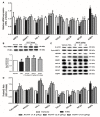Xiaochaihutang Improves the Cortical Astrocyte Edema in Thioacetamide-Induced Rat Acute Hepatic Encephalopathy by Activating NRF2 Pathway
- PMID: 32372950
- PMCID: PMC7179068
- DOI: 10.3389/fphar.2020.00382
Xiaochaihutang Improves the Cortical Astrocyte Edema in Thioacetamide-Induced Rat Acute Hepatic Encephalopathy by Activating NRF2 Pathway
Abstract
Oxidative stress induced by high ammonia, which leads to astrocyte edema, is the key to acute hepatic encephalopathy (AHE). Nuclear factor erythroid 2-related factor 2 (NRF2) has been implicated in oxidative stress, but the mechanism of NRF2 against ammonia-induced astrocytes edema has not been fully studied. We confirmed that the NRF2 pathway is related to brain edema caused by AHE and found that Xiaochaihutang (XCHT) could effectively activate the NRF2 pathway to treat AHE. The model of AHE was established with thioacetamide (TAA) in rats. Rat behaviors were observed, brain water content, blood ammonia levels, glutamine synthetase (GS), malondialdehyde (MDA), and total superoxide dismutase (T-SOD) were determined after XCHT treatment. Furthermore, the expression of NRF2 pathway proteins and mRNA, glial fibrillary acidic protein (GFAP) and aquaporins 4 (AQP4) were examined. In order to determine whether XCHT has a direct effect on cerebral edema caused by high ammonia, we examined the effect of XCHT compound serum on cortical astrocytes in the presence of ammonia, through microscopic observation and immunofluorescence (IF). Results showed that AHE induced by TAA changed the behavior of the rats, and increased brain water content, blood ammonia levels, GS and MDA content meanwhile decreasing T-SOD, but these symptoms were improved by treatment with XCHT. XCHT protected brain edema by activating the NRF2 pathway and increasing the expression of downstream proteins and genes. Astrocytes treated with 5 mM ammonia also showed an increase in the AQP4 protein expression but a decrease in XCHT compound serum and ammonia-induced cell edema groups. This study demonstrates that the NRF2 pathway is involved in the brain edema in AHE, and XCHT may represent a useful prescription for the treatment of AHE.
Keywords: NRF2 pathway; Xiaochaihutang; acute hepatic encephalopathy; astrocyte edema; brain edema.
Copyright © 2020 Jia, Liu, Hu, Hu, Tang, Li and Li.
Figures






Similar articles
-
Role of cerebral endothelial cells in the astrocyte swelling and brain edema associated with acute hepatic encephalopathy.Neuroscience. 2012 Aug 30;218:305-16. doi: 10.1016/j.neuroscience.2012.05.006. Epub 2012 May 17. Neuroscience. 2012. PMID: 22609932 Free PMC article.
-
Xiaochaihutang Inhibits the Activation of Hepatic Stellate Cell Line T6 Through the Nrf2 Pathway.Front Pharmacol. 2019 Jan 7;9:1516. doi: 10.3389/fphar.2018.01516. eCollection 2018. Front Pharmacol. 2019. PMID: 30666206 Free PMC article.
-
Xiaochaihutang attenuates liver fibrosis by activation of Nrf2 pathway in rats.Biomed Pharmacother. 2017 Dec;96:847-853. doi: 10.1016/j.biopha.2017.10.065. Epub 2017 Nov 6. Biomed Pharmacother. 2017. PMID: 29078262
-
Glutamine synthetase in brain: effect of ammonia.Neurochem Int. 2002 Aug-Sep;41(2-3):123-42. doi: 10.1016/s0197-0186(02)00033-5. Neurochem Int. 2002. PMID: 12020613 Review.
-
Interaction of oxidative stress, astrocyte swelling and cerebral ammonia toxicity.Curr Opin Clin Nutr Metab Care. 2010 Jan;13(1):87-92. doi: 10.1097/MCO.0b013e328333b829. Curr Opin Clin Nutr Metab Care. 2010. PMID: 19904201 Review.
Cited by
-
New Insight Into Mechanisms of Hepatic Encephalopathy: An Integrative Analysis Approach to Identify Molecular Markers and Therapeutic Targets.Bioinform Biol Insights. 2023 Feb 17;17:11779322231155068. doi: 10.1177/11779322231155068. eCollection 2023. Bioinform Biol Insights. 2023. PMID: 36814683 Free PMC article.
-
Comparative role of acetaminophen, carbon tetrachloride and thioacetamide in development of fibrosis in rats.Toxicol Res (Camb). 2023 Dec 12;13(1):tfad114. doi: 10.1093/toxres/tfad114. eCollection 2024 Feb. Toxicol Res (Camb). 2023. PMID: 38179004 Free PMC article.
-
Retention enema with traditional Chinese medicine for hepatic encephalopathy: A protocol for a systematic review and meta-analysis.Medicine (Baltimore). 2020 Oct 2;99(40):e22517. doi: 10.1097/MD.0000000000022517. Medicine (Baltimore). 2020. PMID: 33019454 Free PMC article.
-
Formation of self-assembly aggregates in traditional Chinese medicine decoctions and their application in cancer treatments.RSC Adv. 2025 Feb 18;15(7):5476-5506. doi: 10.1039/d4ra07212j. eCollection 2025 Feb 13. RSC Adv. 2025. PMID: 39967882 Free PMC article. Review.
-
2021 ISHEN guidelines on animal models of hepatic encephalopathy.Liver Int. 2021 Jul;41(7):1474-1488. doi: 10.1111/liv.14911. Epub 2021 May 11. Liver Int. 2021. PMID: 33900013 Free PMC article. Review.
References
-
- Cao L.-J., Li H.-D., Yan M., Li Z.-H., Gong H., Jiang P., et al. (2016). The protective effects of isoliquiritigenin and glycyrrhetinic acid against triptolide-induced oxidative stress in HepG2 cells involve Nrf2 activation. Evid. Based. Complement. Alternat. Med. 2016, 8912184. 10.1155/2016/8912184 - DOI - PMC - PubMed
LinkOut - more resources
Full Text Sources
Other Literature Sources
Miscellaneous

